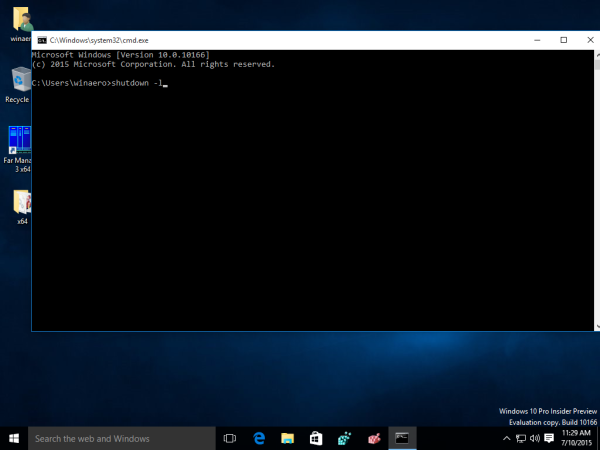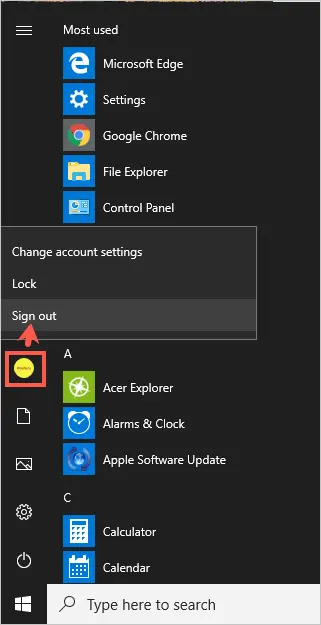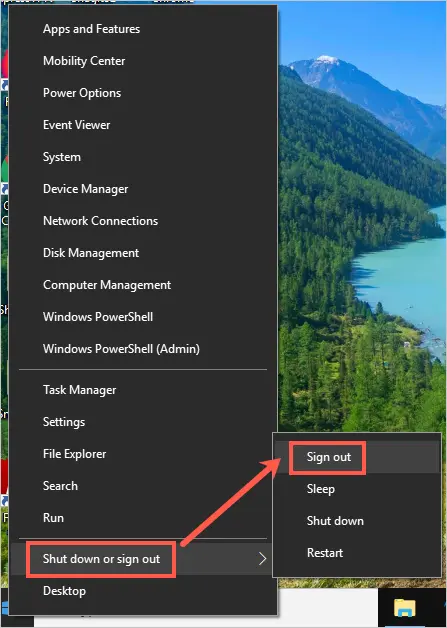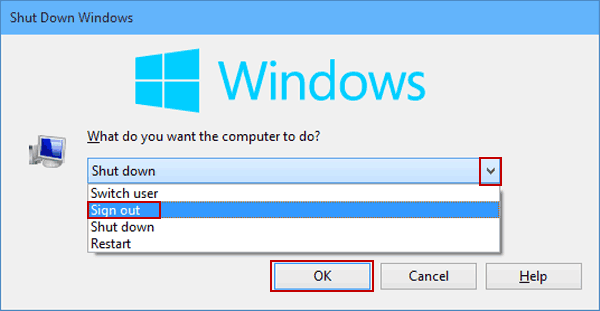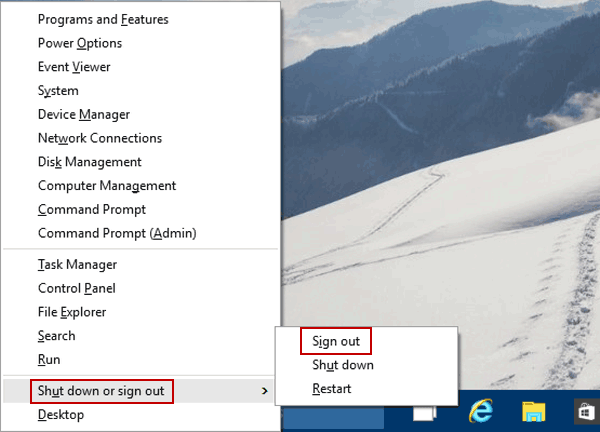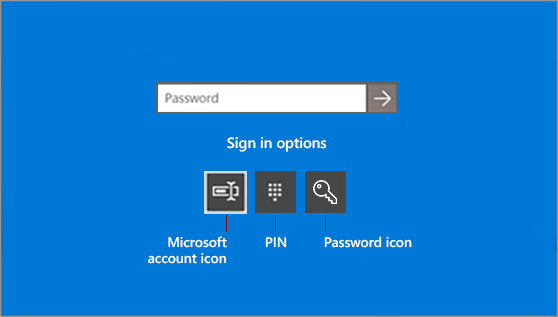Sign out windows что это
How to Log off Computer or Sign out from Windows 11/10
If you are new to Windows 11/10 and want to learn how you can Log off the computer or Sign out of your Windows after your work is complete, then this basic tutorial is for you. Not only you will learn this, but you will also see how you can Log off in multiple ways.
What happens when you Log off a computer?
Before we start with the methods, let’s first understand what happens when you Log off or Sign out. Windows will close all the user applications running in the background, close all files, but leave the computer running. Once you are logged out, you should see the Log-in screen.
If your computer is used often, then it’s best to Log Off and keep it running, which will save you from waiting until the computer restarts.
How to Log off Computer or Sign out from Windows 11/10
If you are wondering which method you need to use, then it depends on which is the most comfortable for you. I end up using Alt+F 4 as it is quicker than the rest.
1] Sign out using Start Menu
It is a standard method where you click on the Start button, then on your profile icon, and click on Sign-out. If there is any unsaved work or a process that is running in the background, you will be prompted to save the work and close the apps.
2] Sign out using the WinX Menu
You can also use WIN+X first, then U to open the flyout menu, and then press Enter to Log off the computer.
3] Alt + Ctrl + Del
It is one of the classic methods we had used whenever the computer used to hang. It launches a screen overlay, which gives you the option to Lock, Switch user, Sign out, and Task Manager. Choose Sign out.
4] ALT+F4 Keyboard shortcut to Log off from the computer
Another classic all-time favorite method I had always used when I was using Windows XP and Windows 7. When on Desktop, press ALT+F4, and it will open a small pop-up window. Here you can choose to Sign out from the drop-down, and then click on the OK button.
5] Sign out from the Command Prompt
You can also execute the same command from the Run prompt.
6] Shortcut to Log off Computer
If you like using Shortcuts to execute commands you use often, then we have written an exhaustive guide on how you can create shutdown, restart, Log off shortcuts on Widows Desktop. You can also choose to assign a keyboard shortcut to that shortcut and execute it anytime you want.
I hope you find one of the methods that suit you to Log off the computer.
Date: December 11, 2020 Tags: Beginners, Guide
Related Posts
How to use Windows 11 – Tutorial for Beginners
How to repair or rebuild the WMI Repository on Windows 11/10
How to remove virus from Windows 10; Malware Removal Guide & Tools for Beginners
[email protected]
Ashish is a veteran Windows, and Xbox user who excels in writing tips, tricks, and features on it to improve your day to day experience with your devices.
All ways to sign out from Windows 10
Windows 10 comes with a different user interface yet again which includes a new Settings app and a different Start menu quite unlike the Windows 7 Start menu or the Windows 8 Start screen. It provides basic functionally that everyone is used to although it does not have submenus for system folders. The power button is now in a different location and the commands to lock or log off are located elsewhere. In case you are interested, let me walk you through all the ways to sign out from your Windows 10 user session.
This will sign out you from Windows 10:
That’s it. Thankfully, Microsoft is keeping these options in Windows 10, so everyone can pick their most preferred way.
Winaero greatly relies on your support. You can help the site keep bringing you interesting and useful content and software by using these options:
If you like this article, please share it using the buttons below. It won’t take a lot from you, but it will help us grow. Thanks for your support!
Author: Sergey Tkachenko
Sergey Tkachenko is a software developer from Russia who started Winaero back in 2011. On this blog, Sergey is writing about everything connected to Microsoft, Windows and popular software. Follow him on Telegram, Twitter, and YouTube. View all posts by Sergey Tkachenko
7 Ways to Log Off or Sign Out from Windows 10 User Account
Windows 10 and other operating systems store all data on a PC based on the logged in user account. It is very common, in family and in public areas, for multiple users to use a single PC. Even one person can have multiple user accounts on a same PC for carrying out different tasks. Windows 10 will prompt you to enter username and password when you login to your computer for booting. After that instance, you can simply log out from one account and switch to another account without shutting down your computer.
Log Off / Sign Out and Switch Account
Before we explain further, there are few confusions when using the word “log off”.
When you log off or sign out, Windows will close all open applications and terminate your account from the connected network. You can switch to another user account or login to the same account again from the lock screen. When you login, you will see the desktop similar to normal startup without any open applications running. All programs need to initialize from the beginning like reconnecting to mapped network drives.
On other hand, switching account will retain all open applications of the previous user when switching to another account. This means you can simply toggle accounts at any point of time and continue where you left after login in both user accounts. All previously open applications will continue to run when switching the account though your network may disconnect and reconnect again.
Understanding this difference in mind, let us explain different ways to sign out of your Windows 10 computer. We use sing out in remaining part of this article with the similar meaning as log off as Windows 10 uses in the same manner. In addition, the possibilities of switching account is mentioned wherever it is applicable.
7 Ways to Log Off or Sign Out from Windows 10 User Account
1. Start Menu
Windows 10 has no sign out or switch account option in the power button on start menu. Microsoft simply removed this option and moved under the user account button. Click on the “Start” button and then click on the logged in user profile picture. You can choose to sign out or switch account from here.
When multiple users are logged in, then you can directly choose different user account to switch the account without signing out from the account.
2. Power Menu
Press “Win + X” shortcut keys or simply right click on the start button to open power menu. Click on “Shut down or sign out” option and choose “Sign out”. As you can see in power menu, you will only have option for signing out and no option for switching account is available.
Sign Out in Power Menu
3. Sign Out from Command Prompt
After pressing “Win + X” keys, choose “Windows PowerShell” option from the menu. Note, if you are not seeing PowerShell then you will see Command Prompt option. You can choose either Command Prompt or Windows PowerShell whatsoever showing in the menu. Enter the command “shutdown /l” and hit enter.
Sign Out from Command Prompt
Windows will sign out instantly and go back to the lock screen.
4. Ctrl + Alt + Del
This is the most popular shortcut to shut down your computer. Here you will have options to sign out or switch account between users.
5. Alt + F4
This is another popular shortcut to close applications in Windows. First, close all open applications and press “Alt + F4”. You will see “Shut Down Windows” popup opens. Click on the dropdown and choose “Sign Out” option.
Sign Out from Alt F4 Options
6. Run Logoff Command
Press “Win + R” to open “Run” dialog box. Type “logoff” and enter to sign out of your account. Windows 10 will signing out of your account instantly.
7. Adding Sign Out or Log Off Shortcut Menu
If you do not like any of the above mentioned method for signing out of your computer then there is a trick you can do to make the process simpler. Type “logoff” in the Windows or Cortana Search Box. You will see the first options as “Logoff” as Run Command which is the option explained in previous step. Right click on that and choose “Open file location”.
Open File Location of Logoff Executable File
This will open the path “C:\Windows\System32” where “logoff.exe” file is stored on your computer. Right click on the “logoff” file and choose “Send to > Desktop (create shortcut)”.
Create Desktop Shortcut for Logoff Option
This will add the shortcut in your desktop for logoff option. Simply double click on the desktop shortcut to quickly sign out of your computer.
Logoff Shortcut on Desktop
Lock with Win + L
Press “Win + L” to lock your computer. Here you will not find any sign out option. However, if your objective is to switch the account to another user then click on “Other user” and login as different user account.
Conclusion
Hope you understand many ways to signing out of your computer without hassle. Note, when you sign out or run logoff command, Windows 10 will immediately start signing out without any notice. Though sometimes you will see a warning message showing there are open applications, it will not help you in saving the working documents. So in order to avoid loss of work, remember to save and close all your working documents and folders before signing out / logoff in any of the methods.
4 Ways to Sign out in Windows 10
Want to log out of Windows 10 in your account and change another guest user account? Here, this article introduces four simple methods to help you sign out on Windows 10 computer.
Video guide on how to sign out in Windows 10:
How to Log out of Windows 10—4 Ways
Way 1: Sign out via the user icon.
Open Start Menu, click the user icon on the top-left corner and choose Sign out in the menu.
Way 2: Sign out through the Shut Down Windows dialog.
Press Alt+F4 to open the Shut Down Windows dialog box, tap the small down arrow, select Sign out and hit OK.
Way 3: Sign out from the Quick Access Menu.
Open the Quick Access Menu by Windows+X, point at Shut down or sign out and choose Sign out in the sub-list.
Way 4: Sign out via the Ctrl+Alt+Del options.
Press Ctrl, Alt and Del keys at the same time, and then select Sign out in the options.
Sign in to Windows
If you’re having problems signing in to a Windows 11 computer, try this first: Enter your password with the onscreen keyboard. Find it by selecting Accessibility on the lock screen. If that doesn’t work, try these steps to find out what kind of account you have.
From the sign-in screen, select Sign-in options. Choose the step below based on the type of account you have.
For a Microsoft account, you can reset your password. Go to the reset password page and follow the instructions.
If you only see the Password icon, you have either a domain (work or school) account or a local account. For a domain account you need help from your system administrator.
For a local account on Windows 11, follow the instructions in Reset your Windows local account password.
If you’re having problems signing in to a Windows 10 computer, try this first: Enter your password with the onscreen keyboard. Find it by selecting Ease of Access on the lock screen. If that doesn’t work, try these steps to find out what kind of account you have.
From the sign-in screen, select Sign-in options. If you see the Microsoft account icon, you’re using a Microsoft account. Choose the step below based on the type of account you have.
For a Microsoft account, you can reset your password. Go to the reset password page and follow the instructions.
If you only see the Password icon, you have either a domain (work or school) account or a local account. For a domain account you need help from your system administrator.
For a local account on Windows 10, prior to version 1803, unfortunately there’s no way to recover a lost password. You can reset the machine back to factory settings by following the steps in Reset or reinstall Windows.
For a local account on Windows 10, version 1803 or later, follow the instructions in Reset your Windows local account password.
